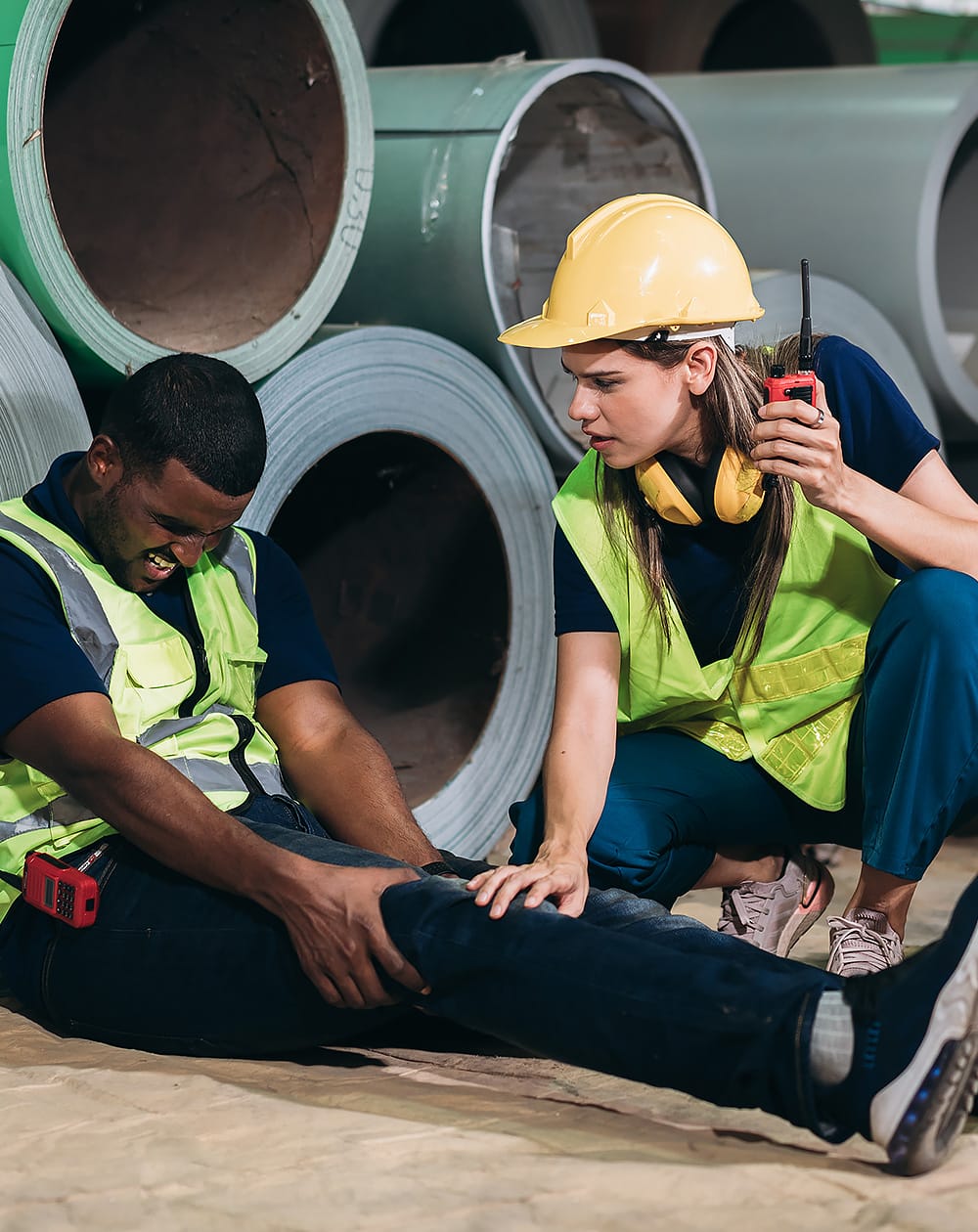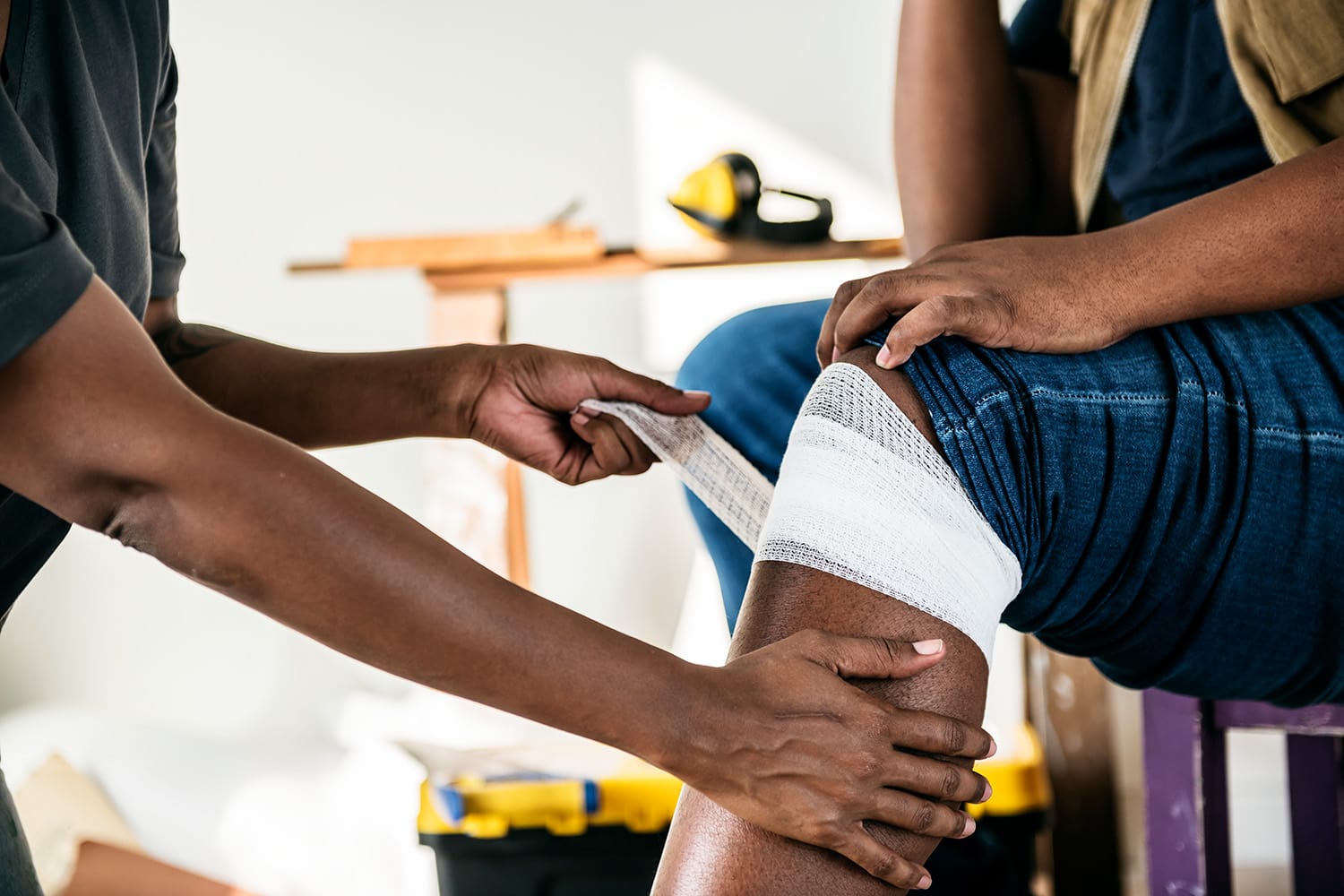Una lesión de rodilla y el consiguiente dolor de rodilla dificultan considerablemente la vida cotidiana y las rutinas. Las lesiones de rodilla no sólo son dolorosas, sino que a menudo son inmovilizadoras. Cuando un trabajador sufre una lesión de rodilla en el trabajo, podría impedirle desempeñar sus funciones y obligarle potencialmente a ausentarse del trabajo, haciéndole perder ingresos y estabilidad financiera. Afortunadamente, los empleadores tienen un seguro de compensación de trabajadores para ayudar a cubrir los gastos médicos de un trabajador y los salarios perdidos cuando se lesionan en el trabajo. La elección de un médico de lesiones de trabajo que pone su salud y bienestar en primer lugar le ayuda a prepararse para la recuperación y su regreso al trabajo.
Su recuperación es nuestra máxima prioridad en Spine and Joint Institute of Milwaukee. En nuestra clínica, nos tomamos el tiempo necesario para evaluar a fondo su lesión de rodilla y su impacto en su vida. A continuación, desarrollamos un plan de tratamiento personalizado adaptado a sus necesidades únicas. Todo el tiempo, documentamos correctamente su lesión y el tratamiento para su caso de compensación de trabajadores para mejorar el valor de su reclamo de beneficios de compensación de trabajadores.
Póngase en contacto con Spine and Joint Institute of Milwaukee hoy mismo para concertar una cita.

El tratamiento de una lesión de rodilla relacionada con el trabajo y el dolor de rodilla depende de la naturaleza específica y la gravedad de la lesión, así como de factores como la salud general de la persona y sus objetivos funcionales. Sin embargo, los tratamientos estándar para las lesiones de rodilla relacionadas con el trabajo pueden incluir:
El reposo de la rodilla afectada suele ser el paso inicial en el tratamiento de las lesiones y el dolor de rodilla, especialmente en la fase aguda. Evitar las actividades que exacerban el dolor o las molestias puede ayudar a prevenir daños mayores y favorecer la curación.
Aplicar hielo en la rodilla lesionada puede ayudar a reducir el dolor, la hinchazón y la inflamación de la rodilla. La terapia con hielo suele recomendarse durante periodos cortos, varias veces al día, durante la fase aguda de la lesión.
Los vendajes o vendas de compresión pueden ayudar a reducir el dolor y la inflamación de la rodilla y a sostener la articulación de la rodilla lesionada. También pueden recomendarse prendas o manguitos de compresión para estabilizar la rodilla durante las actividades.
Elevar la rodilla lesionada por encima del nivel del corazón puede ayudar a reducir la hinchazón y favorecer el drenaje de líquidos de la zona. Mantener la rodilla elevada, especialmente durante los periodos de descanso o sueño, puede ayudar a la curación.
La fisioterapia suele ser un componente clave de la rehabilitación de lesiones y dolores de rodilla relacionados con el trabajo. Un fisioterapeuta puede diseñar un programa de ejercicios personalizado para mejorar la fuerza, la flexibilidad y la amplitud de movimiento de la rodilla y abordar cualquier problema biomecánico subyacente o desequilibrio muscular.
Pueden recomendarse antiinflamatorios no esteroideos (AINE), como el ibuprofeno o el naproxeno, para ayudar a aliviar el dolor y la inflamación de rodilla asociados a una lesión de rodilla. En algunos casos, las inyecciones de corticosteroides pueden reducir la inflamación y aliviar los síntomas.
Dependiendo de la naturaleza de la lesión de rodilla, el uso de una rodillera o de dispositivos ortopédicos puede ser beneficioso para proporcionar estabilidad, apoyo y alineación a la articulación durante las actividades.
En casos de lesiones de rodilla graves o complejas, puede ser necesaria una intervención quirúrgica para reparar los tejidos dañados, como ligamentos, tendones o cartílagos. Los procedimientos quirúrgicos pueden incluir cirugía artroscópica, reconstrucción de ligamentos, reparación de meniscos o cirugía de sustitución de rodilla.
Las personas con lesiones y dolores de rodilla relacionados con el trabajo deben someterse sin demora a la evaluación y el tratamiento médicos de un profesional sanitario cualificado para determinar el curso de acción más adecuado en función de su estado específico y sus objetivos funcionales. Seguir las recomendaciones del tratamiento, respetar los protocolos de rehabilitación y reincorporarse gradualmente al trabajo bajo supervisión médica puede ayudar a optimizar la recuperación y minimizar el riesgo de volver a lesionarse.

Si sufre una lesión de rodilla en el trabajo, actúe con rapidez para garantizar una atención adecuada y facilitar la recuperación. Tomar estas medidas proactivas tras sufrir una lesión de rodilla en el trabajo puede facilitar su recuperación, minimizar el impacto en su vida diaria y sus responsabilidades laborales, y garantizar una vuelta al trabajo segura y satisfactoria. Esto es lo que debe hacer después de lesionarse la rodilla en el trabajo:
Evalúe la gravedad de su lesión de rodilla. Si experimentas dolor intenso en la rodilla, hinchazón o dificultad para soportar peso sobre la rodilla afectada, busca atención médica inmediata.
Informa de la lesión a tu empresa lo antes posible, siguiendo los procedimientos de notificación de lesiones de tu lugar de trabajo. Esta documentación es vital para las reclamaciones de indemnización de los trabajadores y garantiza que recibas apoyo y adaptaciones.
Concierte una cita con un profesional sanitario, como un médico o un especialista en salud laboral, para que evalúe a fondo su lesión de rodilla. Ellos pueden evaluar el alcance de la lesión, proporcionar un diagnóstico y recomendar el tratamiento adecuado.
Siga el plan de tratamiento prescrito por su profesional sanitario, que puede incluir reposo, terapia con hielo, compresión, elevación, ejercicios de fisioterapia, medicamentos o, en casos graves, intervención quirúrgica. Cumplir el protocolo de tratamiento recomendado favorece la curación y evita complicaciones posteriores.
Si su lesión de rodilla afecta a su capacidad para desempeñar sus funciones laborales, comunique a su empleador cualquier adaptación o modificación necesaria de sus tareas, horario o entorno de trabajo. Esto puede implicar asignaciones temporales de trabajo ligero, ajustes ergonómicos o puestos de trabajo modificados para adaptarse a su lesión y facilitar al mismo tiempo una reincorporación segura y oportuna al trabajo.
Si se le prescribe, participe activamente en programas de fisioterapia o rehabilitación para fortalecer los músculos que rodean la rodilla, mejorar la flexibilidad y recuperar la movilidad funcional. La participación constante en ejercicios de rehabilitación puede acelerar la recuperación y reducir el riesgo de volver a lesionarse.
Acuda a las citas de seguimiento programadas con su profesional sanitario para supervisar sus progresos, ajustar los planes de tratamiento según sea necesario y abordar cualquier duda o complicación que surja durante el proceso de recuperación.
Mantenga informada a su empresa de sus progresos, de cualquier cambio en su estado de salud y de cualquier dificultad o limitación que pueda encontrar durante su recuperación. La comunicación abierta garantiza que su empresa pueda proporcionarle el apoyo y las adaptaciones necesarias para facilitar su reincorporación al trabajo.
Familiarícese con sus derechos en virtud de las leyes y políticas de indemnización por accidente laboral de su jurisdicción. Las prestaciones de indemnización por accidente de trabajo pueden incluir cobertura de gastos médicos, costes de rehabilitación, pérdida de salario y prestaciones por incapacidad relacionadas con tu lesión de rodilla relacionada con el trabajo.
Cuídese dando prioridad al descanso, la nutrición adecuada, la hidratación y el control del estrés durante la recuperación. Escucha a tu cuerpo, evita las actividades que exacerben el dolor o las molestias y date el tiempo y el apoyo necesarios para curarte por completo.
Entre los tipos habituales de lesiones de rodilla que pueden producirse en el lugar de trabajo se incluyen:
Distensiones y esguinces. Las distensiones implican el estiramiento o desgarro de los músculos o tendones que rodean la rodilla, mientras que los esguinces implican el estiramiento o desgarro de los ligamentos que estabilizan la articulación de la rodilla. Estas lesiones pueden deberse a sobreesfuerzos, movimientos bruscos o esfuerzos repetitivos sobre la rodilla.
Lesiones de ligamentos. Las lesiones de los ligamentos de la rodilla, como el ligamento cruzado anterior (LCA), el ligamento cruzado posterior (LCP), el ligamento colateral medial (LCM) o el ligamento colateral lateral (LCL), pueden producirse por torsión, hiperextensión o impacto directo en la rodilla. Estas lesiones son comunes en ocupaciones que implican cambios frecuentes de dirección, levantar objetos pesados o contacto físico.
Desgarros de menisco. El menisco es una estructura cartilaginosa en forma de C que amortigua y estabiliza la articulación de la rodilla. Los desgarros de menisco pueden producirse debido a movimientos bruscos de torsión, flexión o agachamiento, que provocan dolor, hinchazón y limitación de la amplitud de movimiento. Los desgarros de menisco son frecuentes en trabajos que requieren arrodillarse, ponerse en cuclillas o levantar peso de forma repetitiva.
Tendinitis rotuliana. También conocida como rodilla de saltador, la tendinitis rotuliana consiste en la inflamación o degeneración del tendón rotuliano, que conecta la rótula con la tibia. Esta afección puede desarrollarse debido a las actividades repetitivas de saltar, correr o arrodillarse todos los días en determinadas ocupaciones, causando dolor y sensibilidad alrededor de la parte delantera de la rodilla.
Bursitis. Las bursas son sacos llenos de líquido que amortiguan y reducen la fricción entre los huesos, tendones y músculos que rodean la articulación de la rodilla. La bursitis de rodilla se produce cuando estos sacos se inflaman debido a esfuerzos repetitivos, arrodillamiento o presión prolongada sobre la rodilla. Puede causar dolor, hinchazón y sensibilidad alrededor de la rodilla.
Fracturas de rodilla. Las fracturas o roturas de los huesos de la rodilla, como la rótula, el fémur o la tibia, pueden producirse por caídas, colisiones o fuertes impactos en el lugar de trabajo. Las fracturas de rodilla suelen ir acompañadas de dolor intenso, hinchazón, hematomas y dificultad para apoyar el peso en la pierna afectada.
Síndrome de la banda iliotibial (ITBS). El ITBS consiste en la inflamación o irritación de la cintilla iliotibial, una gruesa banda de tejido que recorre la parte externa del muslo desde la cadera hasta la tibia. Los movimientos repetitivos de flexión y extensión de la rodilla, como los que se requieren al correr, montar en bicicleta o subir escaleras, pueden contribuir a la ITBS, causando dolor y molestias en la cara externa de la rodilla.
Dislocaciones y subluxaciones. Las luxaciones se producen cuando los huesos de la articulación de la rodilla se ven forzados a salir de su alineación normal, mientras que las subluxaciones implican un desplazamiento parcial de la articulación. Estas lesiones pueden producirse por caídas, impactos bruscos o movimientos de torsión, y causar dolor intenso, inestabilidad e hinchazón en la rodilla.
Las personas deben ser conscientes de los riesgos y peligros potenciales en su lugar de trabajo y tomar medidas proactivas para prevenir las lesiones de rodilla, como utilizar técnicas de elevación adecuadas, llevar calzado de apoyo, utilizar equipos ergonómicos y aplicar protocolos de seguridad y programas de formación. Además, para una recuperación y rehabilitación óptimas es esencial someterse rápidamente a una evaluación y tratamiento médicos de las lesiones de rodilla sufridas en el lugar de trabajo.

El LCA desempeña un papel crucial en la estabilización de la rodilla, especialmente durante las paradas bruscas, los cambios de dirección y los movimientos de giro. Una rotura del LCA es un desgarro o rotura del ligamento cruzado anterior (LCA), uno de los principales ligamentos de la articulación de la rodilla. Esto es lo que debe saber sobre la rotura del LCA:
En general, una rotura del LCA es una lesión importante de la rodilla que puede afectar profundamente a la movilidad, la funcionalidad y la calidad de vida de una persona. Acudir rápidamente al médico, obtener un diagnóstico preciso y seguir las estrategias de tratamiento y rehabilitación adecuadas son pasos clave para tratar eficazmente una rotura del LCA y maximizar las posibilidades de una recuperación satisfactoria.
Una lesión y dolor de rodilla sufridos en el trabajo pondrán su vida en pausa y desafiarán su seguridad financiera. Los médicos especializados en lesiones laborales del Spine and Joint Institute of Milwaukee saben por lo que está pasando y le proporcionarán la atención y el apoyo esenciales en cada paso de su proceso de curación. Con nuestra experiencia y pericia en lesiones laborales, le ayudaremos a construir su reclamación de compensación laboral resultante de su lesión de rodilla documentando cada detalle de su lesión y tratamiento. En Spine and Joint Institute of Milwaukee, puede estar seguro de que está en buenas manos.
Luchar contra una lesión de rodilla puede provocar mucho dolor e incertidumbre. Sin embargo, usted puede estar seguro de que nuestros profesionales médicos en Spine and Joint of Milwaukee le ayudarán a asegurar su recuperación con su plan de tratamiento personalizado, mientras que la construcción de la documentación de su reclamo de compensación de trabajadores al mismo tiempo. Programe una cita con nuestros experimentados proveedores médicos en Spine and Joint Institute of Milwaukee hoy mismo.

Si usted no está recibiendo la atención adecuada para su lesión, usted tiene el derecho bajo la Ley de Compensación de Trabajadores de Wisconsin para elegir a su propio médico y para obtener una segunda opinión.